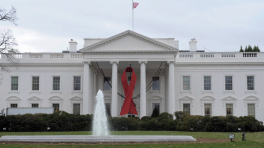Health Care Blog
Ashley-Care: Gaining Peace of Mind by Getting Coverage Through a Parent’s Health Plan
Posted by on September 20, 2012 at 10:00 AM ESTEd. note: This is cross-posted from Healthcare.gov.
Ashley Matthews, recent graduate of the University of Miami School of Law, considers herself very aware of what is going on the world. But she admits, “Because I am so young, health care never entered my universe.” That is, until she got into a car accident one evening. That’s when she realized she didn’t have health insurance.
As she recalls: “I’m laying on the hospital bed … my shoes were knocked off my feet, my tooth is chipped and my knee is bleeding and I thought about the fact that I had just graduated from undergrad [and] I had no health care insurance because I wasn’t on my parents’ plan and this is right before the Affordable Care Act.” Although the doctor wanted her to stay in the hospital for treatment, Ashley and her friends quickly left because she would not be able to afford the care without health insurance. “The threat of the bills was enough to send me running from the hospital,” she says.
Because of the Affordable Care Act, Ashley was later able to be added to her parents’ insurance. More than 3 million young adults have been able to gain health insurance through their parents’ health plans until they turn age 26 as a result of the new health care law. “When I found out that I could stay on my parents’ insurance, it was like a blessing,” she says.
Watch MyCare: Ashley M. in Miami, FL here.
Learn more about Health CareThe Health Care Law is Saving Americans Money
Posted by on September 11, 2012 at 11:18 AM ESTEd. note: This is cross-posted from Healthcare.gov.
The Affordable Care Act holds insurance companies accountable and puts more money back into the pockets of Americans across the country. According to a new report, consumers saved over $2 billion because of new rules that protect people from insurance industry abuses.
As a former Insurance Commissioner, I’m familiar with how alone consumers can feel when dealing with their insurance companies. Under the health care law, insurers are finally being held accountable to their policyholders. For the first time ever, new rate review rules in the health care law prevent insurance companies in all states from raising rates with no accountability or transparency. Forty-five states and the District of Columbia have received $160 million in grants to increase their oversight of premium hikes.
Some states, like Nevada, are using the funds to better educate consumers about the resources available to them. Others – like Mississippi and South Dakota – have used the money to add new consumer protections. In these states, officials can not only review rate hikes, but can also reject those hikes that are not justified.
Learn more about Health CareWeekly Address: Preserving and Strengthening Medicare
Posted by on August 25, 2012 at 4:30 AM ESTPresident Obama speaks to the American people about the critical need to strengthen and preserve Medicare for our seniors and future generations.
Transcript | Download mp4 | Download mp3
Learn more about Health CareImplementation of the National HIV/AIDS Strategy: Grand Rounds at the CDC
Posted by on August 24, 2012 at 11:00 AM ESTThis week, I traveled to the Centers for Disease Control and Prevention’s (CDC) headquarters in Atlanta to present at CDC’s Public Health Grand Rounds, an ongoing series of monthly presentations on health-related topics pertinent to the health of Americans.
This session consisted of four presentations directly relevant to the National HIV/AIDS Strategy (NHAS). After introductory remarks by CDC Director Dr. Tom Frieden, Dr. Jonathan Mermin presented “The Science of Optimizing HIV Prevention,” describing strategies to maximize the effectiveness of HIV prevention strategies, including integration of prevention and clinical care at the local level. Dr. Irene Hall presented “HIV Surveillance in Action,” reviewing advances in HIV surveillance that enable CDC data to be used for public health action at the provider and individual level. Dr. Stephanie Sansom followed with “Modeling to Identify Optimal Allocation of HIV Prevention Resources in a City Health Department,” focusing on how Philadelphia has used evidence-based modeling to set resource allocation priorities.
I closed the session by providing an overview of NHAS implementation, emphasizing the importance of the Affordable Care Act in helping to meet NHAS goals and improving the health and wellness of people living with HIV. These presentations are an excellent reminder of the critical ongoing role that NHAS plays in fighting domestic epidemic. To watch this month’s Public Health Grand Rounds, please visit the CDC website.
Grant Colfax is the Director of the Office of National AIDS Policy.
Learn more about Health CareJill-Care: Pre-Existing Condition Insurance Plan Keeps Her Running
Posted by on August 15, 2012 at 10:21 AM ESTEd. note: This is cross-posted from healthcare.gov.
Jill from North Carolina is a writer and a tutor, but she’s also a runner. A few years ago, she was even training for the Olympic trials in the marathon. But one day, she suddenly passed out in a parking lot. She was diagnosed with a heart condition, atrioventricular nodal reentrant tachycardia (AVNRT).
The good news was that the condition could be remedied with a surgical procedure.
The bad news was that Jill could not afford the surgery.
For years following her diagnosis, she lived within reach of a cell phone just in case she had to call 911. Her condition worsened. “I did stop running; I stopped exercising completely because any kind of exertion would trigger an episode. So I went from running marathons competitively to doing nothing,” Jill says.
She applied for insurance that might cover her surgery, but was turned down due to her pre-existing condition. Her appeal was denied.
There didn’t seem to be a place in the health care system for her situation.
In 2011, Jill heard about the Pre-Existing Condition Insurance Plan (PCIP). PCIP is a program created by the health care law. It is designed to provide affordable health coverage for people who were otherwise locked out of the private system. It also serves as a bridge to 2014, when insurance companies are prohibited from refusing to sell coverage based on someone’s pre-existing condition.
Learn more about Health CareVice President Biden Speaks to the Disabled American Veterans
Posted by on August 7, 2012 at 9:19 AM ESTSaturday, Vice President Biden spoke with the Disabled American Veterans (DAV) at their 91st National Convention in Las Vegas.
The 1.2 million-member DAV is made up exclusively of men and women that have been wounded while defending the nation. This group is dedicated to one, single purpose – building better lives for all our nation’s disabled veterans and their families.
The Vice President thanked the men and women for their service and sacrifices and for continuing to serve by supporting their fellow disabled veterans. He also encouraged them to continue fighting for the benefits that they have earned, need and deserve.
During his address to a crowd of almost 4,000 disabled veterans, Vice President Biden stressed, “Let me be crystal, absolutely crystal clear: we’re going to keep our commitment to American veterans, no matter what happens.”
Learn more about Health Care, Veterans
- &lsaquo previous
- 1
- 2
- 3
- 4
- 5
- 6
- 7
- 8
- 9
- …
- next &rsaquo









